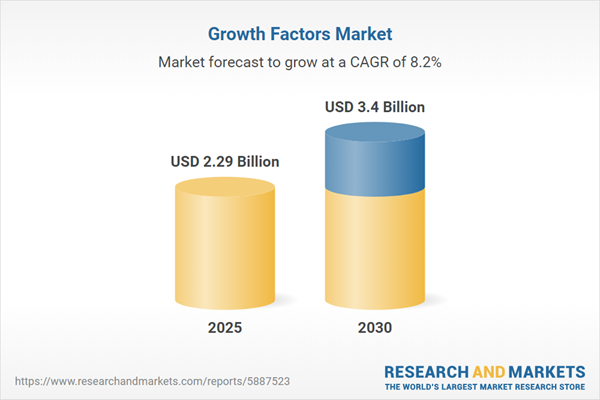Speak directly to the analyst to clarify any post sales queries you may have.
The global growth factors market is evolving rapidly, shaped by scientific advances, regulatory changes, and industry-wide shifts toward collaborative innovation. Senior leaders must stay ahead of technological and commercial developments to capture sustained value and address sector-specific challenges.
Market Snapshot: Growth Factors Market
The Growth Factors Market grew from USD 2.12 billion in 2024 to USD 2.29 billion in 2025. It is expected to continue growing at a CAGR of 8.16%, reaching USD 3.40 billion by 2030. This expansion signals strong demand across therapeutic, research, and manufacturing applications, as healthcare innovation accelerates and new translational pathways emerge. Competitive intensity and technological investment remain high as stakeholders seek to navigate a shifting landscape of cost structures and regional growth drivers.
Scope & Segmentation of the Growth Factors Market
This report delivers a comprehensive analysis of the global growth factors market, providing a granular breakdown across key segments and technologies to guide investment, partnership, and operational strategy.
- Product Types: Epidermal Growth Factors, Fibroblast Growth Factors, Interleukins, Platelet-Derived Growth Factors, Transforming Growth Factor subcategories including Activin, Bone Morphogenetic Proteins, and TGF-beta proteins, Tumor Necrosis Factors, and Vascular Endothelial Growth Factors.
- Grade: GMP Grade, Non-GMP Grade.
- Application Areas: Bone Repair, Cancer Therapy, Cardiovascular Diseases, Hematologic and Oncologic Diseases, Neurological Disorders, Regenerative Medicine, Research, Wound Healing.
- End Users: Contract Manufacturing Organizations (CMO), Contract Development and Manufacturing Organizations (CDMO), Pharmaceutical & Biotechnology Companies, Research Centers, Academic Institutes.
- Regional Coverage: Americas (United States, Canada, Mexico, Brazil, Argentina, Chile, Colombia, Peru), Europe (United Kingdom, Germany, France, Russia, Italy, Spain, Netherlands, Sweden, Poland, Switzerland), Middle East (United Arab Emirates, Saudi Arabia, Qatar, Turkey, Israel), Africa (South Africa, Nigeria, Egypt, Kenya), Asia-Pacific (China, India, Japan, Australia, South Korea, Indonesia, Thailand, Malaysia, Singapore, Taiwan).
- Company Developments: Analysis covers strategic activity by companies including AbbVie Inc., Amgen Inc., AstraZeneca PLC, Bayer AG, Becton Dickinson and Company, Bio-Rad Laboratories Inc., Bio-Techne Corporation, Eli Lilly and Company, F. Hoffmann-La Roche AG, Johnson & Johnson Services, Inc., Merck & Co., Novartis AG, Pfizer Inc., Thermo Fisher Scientific Inc., and others.
Key Takeaways: Strategic Insights for Decision-Makers
- Breakthroughs in recombinant protein engineering and next-generation production platforms are shortening R&D cycles and advancing novel growth factor analogues.
- Digital tools, including artificial intelligence, predictive modeling, and real-time data platforms, are enhancing process efficiency and accelerating the translation from research to clinical deployment.
- Stakeholders are diversifying supply bases and adopting flexible contracting to navigate tariff volatility and changing raw material costs.
- Collaborative ecosystems, such as industry-academic partnerships and joint ventures, are driving innovation while spreading risk and facilitating technology transfer.
- Regional markets show differentiated growth patterns, with North America and Asia-Pacific leading investment in advanced biologics and manufacturing scalability, while EMEA focuses on regulatory integration and capacity-building initiatives.
- Quality grade selection remains critical for stakeholders balancing cost, speed, and compliance, particularly in settings where clinical or research-grade requirements diverge.
Tariff Impact: Navigating US Market Dynamics in 2025
Recent US tariff adjustments have increased input costs and catalyzed strategic shifts in the sourcing and manufacturing footprints of growth factor suppliers. Organizations are accelerating domestic production, strengthening supply chain flexibility, and optimizing procurement practices to manage new risks and maintain competitive positioning.
Methodology & Data Sources
The analysis integrates primary interviews with senior executives, scientific leaders, and supply chain experts, coupled with extensive secondary research from peer-reviewed journals, regulatory databases, and industry proceedings. Data triangulation and cross-validation ensure accuracy and robust insight throughout the report.
Why This Report Matters: Actionable Intelligence for Leadership Teams
- Enables organizations to benchmark innovation pipelines, commercialization strategies, and operational models against leading global practices.
- Supports proactive risk management, supply chain optimization, and investment targeting by delivering detailed segmentation and emerging market analysis.
- Equips decision-makers with the knowledge to navigate complex regulatory, technological, and competitive environments within the growth factors sector.
Conclusion
Senior executives relying on the Global Growth Factors Market report gain strategic guidance for adapting to dynamic innovation cycles, regulatory shifts, and global trade developments. Well-informed planning will be essential to capitalize on opportunities and ensure sustainable market leadership in this evolving arena.
Additional Product Information:
- Purchase of this report includes 1 year online access with quarterly updates.
- This report can be updated on request. Please contact our Customer Experience team using the Ask a Question widget on our website.
Table of Contents
3. Executive Summary
4. Market Overview
7. Cumulative Impact of Artificial Intelligence 2025
Companies Mentioned
The companies profiled in this Growth Factors market report include:- AbbVie Inc.
- Abcam PLC by Danaher Corporation
- Akron Biotechnology LLC
- Amgen Inc.
- Applied Biological Materials Inc.
- AstraZeneca PLC
- Bayer AG
- Becton, Dickinson and Company
- Bio-Rad Laboratories Inc.
- Bio-Techne Corporation
- Cell Guidance Systems LLC
- Cell Signaling Technology, Inc.
- CellDerma LTD
- Creative Bioarray
- Eli Lilly and Company
- Endeavor BioMedicines, Inc
- F. Hoffmann-La Roche AG
- Gemini BioProducts LLC
- Johnson & Johnson Services, Inc.
- Leadgene Biomedical, Inc.
- Lonza Group AG
- Merck & Co., Inc.
- Meridian Bioscience Inc.
- Miltenyi Biotec B.V. & Co. KG
- Novartis AG
- PeptiGrowth Inc.
- Pfizer Inc.
- Prospec-Tany Technogene Ltd.
- Proteintech Group, Inc.
- Qkine Ltd.
- Repligen Corporation
- Reprocell Inc.
- Rockland Immunochemicals, Inc.
- Sartorius AG
- Sino Biological, Inc.
- Thermo Fisher Scientific Inc.
- Xtant Medical Holdings, Inc.
Table Information
| Report Attribute | Details |
|---|---|
| No. of Pages | 182 |
| Published | November 2025 |
| Forecast Period | 2025 - 2030 |
| Estimated Market Value ( USD | $ 2.29 Billion |
| Forecasted Market Value ( USD | $ 3.4 Billion |
| Compound Annual Growth Rate | 8.1% |
| Regions Covered | Global |
| No. of Companies Mentioned | 38 |









